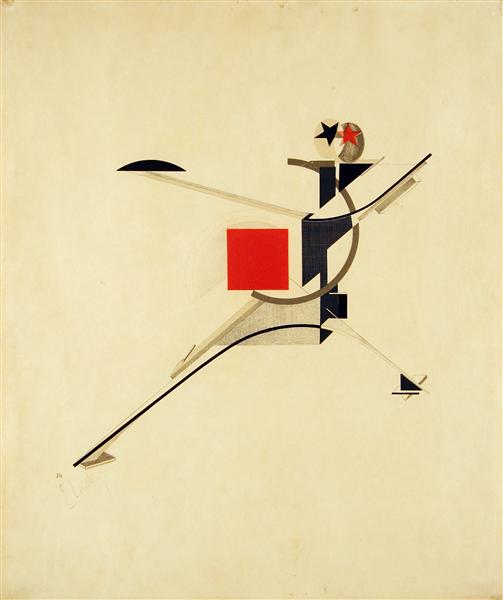Description
In the context of the avant -garde art of the twentieth century, few figures emerge with as much particularity and innovation as the Lissitzky, whose real name was Lazar Markovich Lissitzky. Born in 1890 in what is today Belarus, Lissitzky was a central figure of constructivism and Russian suprematism, movements that sought to reinvent the basis of art after the Russian revolution. His "new man" painting of 1923 is one of the most representative works of his attempt to link art with social transformation, postulating a vision of the future where geometry and form are vehicles of change.
"New Man" is an emblematic piece that synthesizes the relationship between form, color and message in the context of constructivist utopism. At first glance, the composition stands out for its apparent geometric simplicity: a set of abstract figures that float in a flat and two -dimensional space. However, a more detained inspection reveals the complexity and intention behind its creation. The work is dominated by three primary colors: blue, red and black, which together with the white of the background, create a strong visual contrast. This deliberate use of color is not free; Each tone has a symbolic resonance that dialogues with the constructivist and supreme theory that Lissitzky promoted.
Blue in "new man" can be interpreted as a representation of rationality and clarity, essential qualities in the new social order that Lissitzky dreamed. The red, vibrant and dominant in some sections, invokes the revolution and dynamism, inevitably guiding the observer towards a perception of movement and transformation. Black, on the other hand, acts as a stabilizer, anchoring the forms and providing a visual reference point that balances the composition.
Observing more closely, it can be seen that the figures, despite their abstraction, are arranged in such a way that they suggest a stylized human body. This representation of the "new man" has no individual features, thus symbolizing the community and ideal of the socialist man, stripped of his bourgeois and reconfigured individualism according to the principles of the new society. The body parts, disarticulated and reensambled in geometric blocks, seem to challenge the traditional anatomy in favor of a new constructivist aesthetic that sees man as an extension of the machine, efficient and functional.
Lissitzky's style in "New Man" reflects his formation and his direct influences, particularly Kazimir Malevich, the founder of suprematism. However, Lissitzky provides his own vision and emphasis on functionality and propaganda, sculpting an iconography that is both a celebration of the new Soviet order and a visual manifesto of his highest aspirations. Important works by Lissitzky such as the "PROUNS" (projects for the affirmation of the new) and his collaboration in "The Red Wedge", used to encapsulate this mixture of art, politics and utopia, showing its multifaceted capacity as a painter, architect and graphic designer .
"New Man" is not a painting that can be measured by the traditional canons of Western art. Instead, invite the viewer to consider the possibilities of a world reconfigured by art and ideology. Lissitzky's look towards the future, encoded in shapes and colors, is a testimony of a historical moment of vast ambition and radical transformation. As such, the work not only belongs to the physical space that it occupies, but also to the continuous narrative of social and artistic evolution.
KUADROS ©, a famous paint on your wall.
Hand-made oil painting reproductions, with the quality of professional artists and the distinctive seal of KUADROS ©.
Art reproduction service with satisfaction guarantee. If you are not completely satisfied with the replica of your painting, we refund your money 100%.

